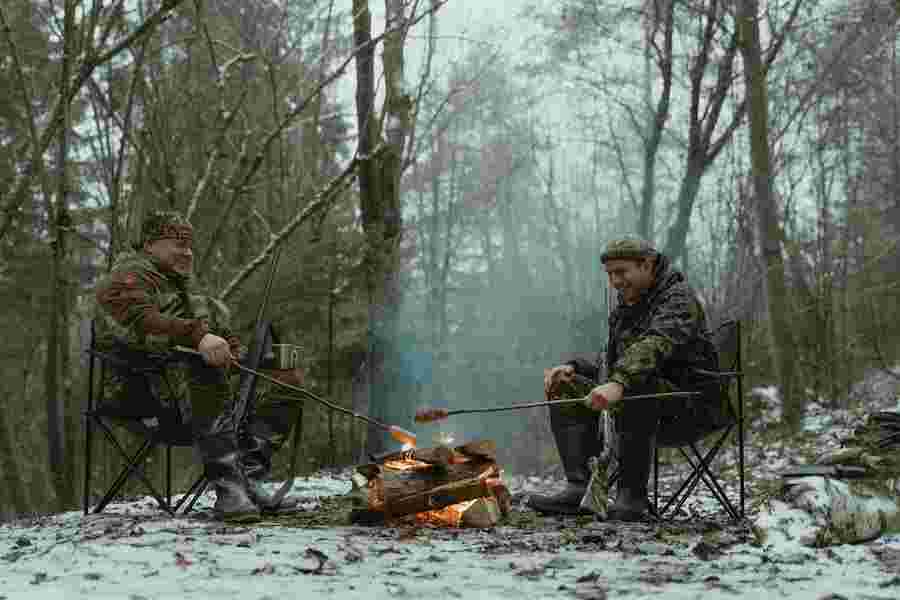
Winter camping is a truly fun and unique experience that is worth having. Picturesque landscapes, a feeling of freshness, glimpses of sun rays on the ice – winter is an amazing season that can change even a place you know well beyond recognition, enveloping it in a breathtaking winter charm. This often makes travel during the winter season popular among many enthusiasts. After all, getting new experiences and enjoying nature with friends is much more fun than sitting at home all winter!
At the same time, winter camping requires preparation. You need to collect the necessary equipment, get a reliable shelter for the duration of your stay in nature, take tent supplies and useful items on the hike, and also find out more information about winter camping to avoid mistakes.
It may seem difficult at first, but winter travel is not as scary as it may seem! Obviously, you shouldn’t go to extreme conditions if this is your first experience of winter camping but you can always find an interesting location and visit it when the temperatures are more comfortable. For example, you can do it in the first weeks of winter or at the end of the season, when the scent of spring is already in the air.
Unlike summer trips, you’ll need more clothing and items for winter camping, so it’s a good idea to start planning and preparing in advance. If you’re a beginner or have little camping experience, it can be difficult to make a checklist of everything you might need at first. In addition, another essential task is to decide how you can transport all your gear to the camp. After all, it’s one thing when you go camping by car and quite another when it’s backpacking.
To make things easier for you, we have put together a list of the main items that you should take with you when going camping. At the same time, you can talk to your friends while planning your trip and decide who can take certain items to evenly distribute the load among everyone.
For convenience, we have sorted items into groups based on their purpose.
Shelter
The key to planning any winter trip is to make sure you have everything you need to have a secure shelter while camping. Things to pay special attention to include:
- Tent. You can use a 3-season tent or a 4-season tent. If you are planning a trip in late fall or early winter to a location with milder winters, then a 3-season tent is quite enough. However, if your camping will take place in extremely low temperatures and heavy snowfalls, then you should take a 4-season tent.
- Footprint & tarp. These items provide extra protection and insulation for your tent. Cover the ground/snow with a footprint and then set up the tent. Also, use a tarp to protect your shelter from water and snow.
- Sleeping bag. Choose a winter sleeping bag in specialized stores. A good tip when buying a sleeping bag is to get one that can withstand slightly lower temperatures than you expect while camping.
- Sleeping pad. This provides additional protection from the cold and helps keep you warm. Buy an R-value of 4 or more pads for winter camping.
- Stove. Take a wood stove or a small portable heater to maintain a comfortable temperature in the tent.
Clothing
For winter camping, wear clothes made from synthetic fabrics instead of natural materials. Fabrics such as cotton are more breathable, so you will lose heat faster. Your best bet is to visit a sports store. Snowboarding and skiing clothing are the ideal choice for winter camping.
The clothes you need to take with you include:
- Several pairs of warm socks, gloves, scarf, hat/balaclava. It is essential to protect primarily areas of the body, such as the foot, arms, neck, and head, since they lose heat most quickly.
- The outer layer of clothing. The purpose of the outer layer of clothing is to protect you from water and moisture, so choose items made from materials with high water resistance.
- The inner layer of clothing. The task of the inner layer of clothing is to retain heat. Warm clothes made from synthetic materials work best here.
- A spare pair of shoes. Wear hard-wearing hiking shoes. It’s important to keep your feet dry at all times, so a spare pair of shoes is a must-have.
- Snowboard goggles. In low temperatures or heavy snow, these glasses will help you see better and not experience discomfort due to watery eyes.
- Portable dryer. This item will help you dry your clothes faster, which is especially critical when camping in the winter.
Personal Items
Each person’s needs are different, so the list of personal items may vary. However, here are the items you definitely need to take:
- First aid kit. Ensure that your first aid kit contains antiseptics and bandages, as well as antiviral, antipyretic, antiallergic, and hemostatic agents. Also, you should have medications that can be used in case of poisoning.
- Toilet paper, paper towels, and wet wipes.
- Toothbrush, toothpaste, sanitizer, soap, antiperspirant, shower gel, and shampoo (dry shampoos and gels work great on a hike).
- Iron mug, plate, cutlery, thermos.
- Chargers, power banks, batteries, flashlights.
- Warmer. Or you can use a hot water bottle. Place a heater in your sleeping bag to warm up faster. Also, you can keep your gadgets and electronics near a warmer or hot water bottle, as cold temperatures damage batteries.
- Emergency communication device. If you travel to remote locations or places with risks of avalanches or heavy snowfalls, then such a device is a necessity.
Kitchen & Cooking
- Firestarter fluid
- Matches with protection from moisture and water
- Several lighters
- Pot set
- Cooking utensils
- Knives, multi tool
- Coffee in stickers
- Tea bags
- Snacks
- Canned food
- Ready-made meals
- Dishwashing detergents
- Garbage bags




















